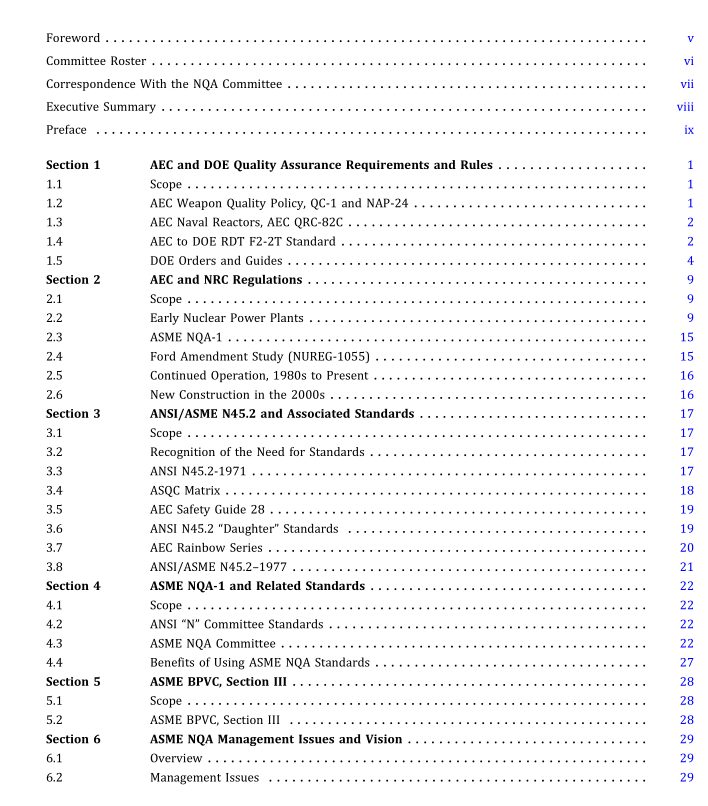ASME NQA.TR:2020 pdf free download Evolution of Quality Assurance Principles and Requirements in the U.S. Nuclear Industry
Acting on the recommendation of an RDT study groupunder Dan Garland to endorse a single national consensusstandard for reactor and technology developmentprograms, in April 1985 RDT management canceledand withdrew RDT F2-2T when it endorsed ANSI/ASME NQA-1-1983.The shift to the ASME NQA-1 nationalconsensus standard was consistent with an Office ofManagement and Budget (OMB) Circular A-119 regardingthe use of such national consensus standards.
A comparison of RDT F2-2T with ANSI/ASMENQA-1-1983 revealed consistencies in their basicquality assurance program elements but significant differ-ences in their degree of specificity, particularly whenapplied to reactor development and testing activities,and in their format.
By endorsing ANSI/ASME NQA-1-1983, the AEC Divi-sion of RDT relinquished its technical and quality manage-ment ability to make rapid, timely, and substantivechanges to quality assurance program requirementsbased on urgent needs backed by field experience.TheASME NQA-1 consensus process achieved thoroughreviews of draft standards but did not lend itself to theprocessing of rapid, program-specific changes.
1.5 DOE ORDERS AND GUIDES
1.5.1 DOE O 5700.6
In March 1978, the DOE Inspector General ( IG) advisedsenior managers at DOE headquarters that lG inspectorswere observing major continuing deficiencies in formalquality assurance programs at DOE field sites.These defi-ciencies included
(a) inadequate or nonexistent quality standards
(b) inadequate design control and design reviews
(c) inadequate supplier controls
(d) inadequate fabrication controls
These deficiencies were attributed in part to the lack ofastrong DOE headquarters quality assurance policy, organ-ization and implementing requirements.For many years,the AEC and DoE national laboratories and contractorshad operated under a system of grants for researchand development that required only periodic progressreports on activities and spending.The AEC requestedbut did not direct quality assurance compliance.
ln response to the lGadvisory, in 1979 the U.S.Secretaryof Energy appointed a study group headed by Phil Coyle ofDP,and which included the author, to develop recommen-dations on a department-wide quality assurance policyand requirements. In January 1981, with the concurrenceof the Secretary of Energy,DOE O 5700.6 was issued.The DOE Nuclear Facility Personnel Qualification andTraining Committee (NFPQT). which was appointed bythe Under Secretary of Energy after the accident atThree Mile lsland in 1979, reported that DOE O 5700.6was being implemented in varying degrees of rigor atmost DoE nuclear facility sites.The NFPQT reported that a common deficiency was the lack of managementcontrols and attention paid by senior DOE and contractormanagers to implementing effective quality assurance re-quirements at DOE nuclear facility sites.
As a result of the NFPQT report, the Under Secretary
of Energy developed a DoE Action Plan. A revisedDOE o 5700.6A was issued in an attempt to strregtseathe department’s dysfunctional quality assurance policy. In September 1986.DOEo 57oo.6B addressedonly changes in DOE headquarters” responsibility for quality assurance oversight.
1.5.2 DOE O 5700.6c
In August 1991, a completely restructured DOE qualityassurance Order, DOEO 5700.6C, was published as a partof a comprehensive DOE directives system. This systemincludes DOE policies, manuals,Orders, Notices,and Regu-latory Rules and Guides for quality assurance plus a
variety of many other documents,which may beaccessed through the DOE Directives website atwww.directives.doe.gov.Information specific to thedepartment’s quality assurance oolicv is availatoletnehttps: f [energy.gov fehss/quality-assurance-policy-and directives.
DOE O 5700.6C established Total Quality Managementarrangement of DOE quality assurance program require-ments into three categories and ten criteria, as follows:
ASME NQA.TR:2020 pdf free download
